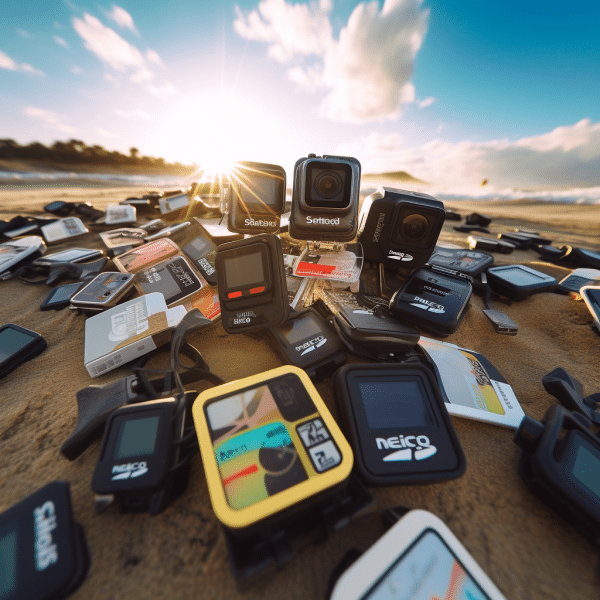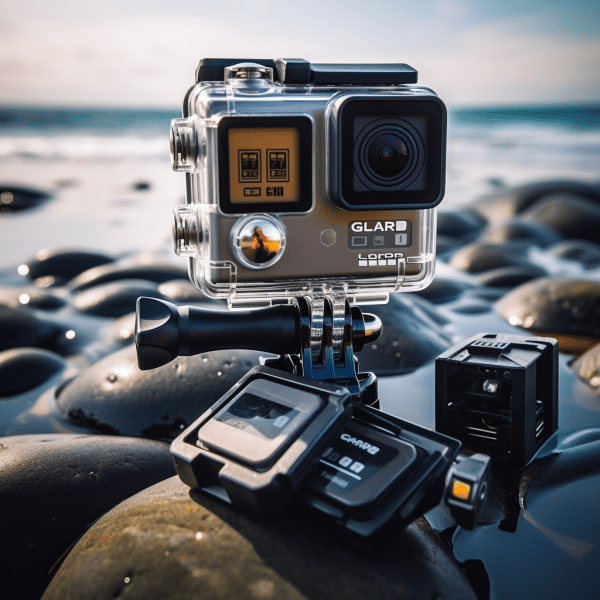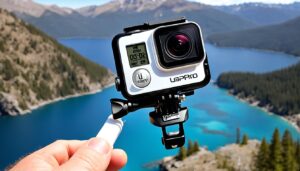
SD Card is one of the most basic yet important things to have if you want to utilize your GoPro camera to its full potential.
An SD card with larger storage will make sure that you can record longer videos, but there are other important specifications that we will discuss today.
First, we will explore what are some of the best choices when it comes to best SD card for GoPro cameras. And then we will explain in depth what are the most important factors when buying an SD card for GoPro.
#1 SanDisk Extreme 64GB microSDXC™
Key Features:
- Capacity : 64 GB
- UHS Class: UHS-I(U3)
- Read Speed : 160 mb/s
- Write Speed: 60 mb/s
- File System: microSDXC
- Durability: Waterproof, Shock Proof, Temperature proof, x-ray proof.
PROS
- High Read and Write Speed
- Up to 8 hours of smooth 4K Video
- Durable
CONS
- No cons
GoPro SanDisk Extreme 64GB microSDXC™
This is by far our top pick when it comes to SD cards for GoPro. Its high writing speed and storage space will allow you to make the most out of your newest GoPro camera.
With write speed up to 60 mb/s and read speed up to 160 mb/s, SanDisk Extreme microSDXC is the obvious first choice for any amateur or professional filmmaker that wants to record high-quality videos.
And just like with others microSDXC cards, it’s possible to record files that are longer than 4GB which is very important. Newer GoPro cameras have great video quality and framerate, and having recordings larger than 4GB will happen often.
#2 SanDisk Extreme 32GB microSDHC™
Key Features:
- Capacity : 32GB
- UHS Class: UHS-I(U3)
- Read Speed : 100 mb/s
- Write Speed: 60 mb/s
- File System: microSDHC
- Durability: Waterproof, Shock Proof, Temperature proof, x-ray proof.
PROS
- Cheap
- Durable
- Reliable
CONS
- 32GB is simply not enough for the never cameras
- You can’t record videos larger than 4GB.
SanDisk Extreme 32GB microSDHC™
Just like SanDisk Extreme microSDXC, this camera is also recommended by the official GoPro website. It also has high reading and writing speed but there are few differences.
This SD card is not only smaller than the 64GB version but has overall slower performance. It has a slower writing speed, slower reading speed, and cannot record videos larger than 4GB.
It’s one of the more reliable SD cards you can buy for this money. But unless you are an amateur, your needs probably won’t be met by this SD card.
#3 Lexar Professional 1000x
Key Features:
- Capacity : 32,64,128 or 256GB
- UHS Class: UHS-II(U3)
- Read Speed : 150 mb/s
- Write Speed : 90 mb/s
- File System: microSDXC
- Durability: Waterproof, Shock Proof, Temperature proof, x-ray proof.
PROS
- One of the fastest SD Cards you can get for this price
- Compatible with UHS-I devices
- Comes with a useful adapter
CONS
- Unreliable
- Has compatibility issues
Lexar Professional 1000x
Supported by all GoPro cameras, Lexar Professional 1000x is a great microSD that is extremely reliable. People online tested it and they are amazed by how great the writing speed of this SD card is.
It comes bundled with a UHS-II adapter so you can transfer your files at a maximum speed. A great feature of this SD card is that it is backward compatible with UHS-1 devices so it performs at a maximum capacity when transferring files or manipulating data
#4 PNY U3 Pro Elite
Key Features:
- Capacity: 32, 64, 128, 256 or 512 GB
- UHS Class: UHS-I(U3)
- Read Speed : 95 mb/s
- Write Speed : 90 mb/s
- File System: microSDXC
- Durability: Waterproof, Shock Proof, Temperature proof, x-ray proof.
PROS
- Comes in many different capacities
- Reliable Company
- Affordable
CONS
- Not that fast
PNY U3 Pro Elite
Great for new generations of GoPro cameras, drones, and smartphones as it can provide you with hours and hours of footage. PNY is a company that specializes in making USB Flash Drives, SSD, HDD, and flash memory cards and they have proven themselves reliable when it comes to high-quality memory.
This SD card is not that expensive yet it provides you with a lot of storage space. It’s also not as fast as, for example, Lexar Professional or SanDisk Extreme microSDXC but it does its job. It’s up to you to decide whether the write and read speed suit you.
#5 Samsung EVO Select MB-MC256GA/AM
Key Features:
- Capacity : 32,64,128, 256 or 512GB
- UHS Class: UHS-I(U3)
- Read Speed : 100 mb/s
- Write Speed : 90 mb/s
- File System: microSDXC
- Durability: Waterproof, Shock Proof, Temperature proof, x-ray proof.
PROS
- Affordable
- Perfect Choice for Hero9
- Reliable
CONS
- Few unsatisfied customers
Samsung EVO Select MB-MC256GA/AM
Samsung EVO 256GB model can hold up to 12 hours of 4K UHD video, making it a perfect choice if you just bought a new Hero9 and you are looking for an SD card that will satisfy your needs in the long run.
It’s very affordable and it still does a great job like all the other SD cards we mentioned before.
Specifications to consider
Storage
The storage is measured in gigabytes and it doesn’t get simpler than the larger the storage, the more you can record. GoPro cameras with each generation need more and more space, and this means that you might need to invest more money in storage.
If you bought the new HERO9, this means that you will record tons of footage in 5K, and this means that you MUST have an SD card with at least 128GB. The newer the camera, the more space you will need.
And it’s always better to have more space than required.
SDXC vs SDHC
This is a very important distinction that you need to make.
microSDHC: Secure Digital High Capacity, these SD cards are usually older and slower models. microSDHC memory cards have a capacity of up to 32GB, and their file size can’t be larger than 4GB(This is a deal-breaker in 2021!). They can record only up to Full HD and they can’t take photos in RAW format.
microSDHC uses FAT32 as a file system.
microSDXC: Secure Digital Extended Capacity these memory cards have a capacity from 32GB to up to 2TB. Physically, they aren’t any different than microSDHC yet they are better in every aspect. Potentially, their speed goes from 50MB/s to 312MB/s but whether they will reach that speed depends on the speed class.
microSDXC uses exFAT as a file system.
A1 vs A2
This stands for Application performance. This feature is something that shouldn’t worry you at all when buying an SD card for your camera. Application performance is the capability of the SD card to run applications from the card. A2 is 3-4 times faster than the A1 and this is usually something that smartphone or tablet users should care about.
Short Guide to Speed Class
Three main things you need to understand about Speed in SD cards are Speed Class, UHS Speed Class, and Video speed class.
Speed Class :
This speed class is named simply and there isn’t much to know about it. It’s denoted with a “C” symbol and there are four ratings within this class.
- C2: Minimum Write speed is 2MB/s
- C4: Minimum Write speed is 4MB/s
- C6: Minimum Write speed is 6MB/s
- C10: Minimum Write speed is 10MB/s
UHS Speed Class :
UHS stands for Ultra High Speed and it’s denoted with a “U” symbol. There are two ratings within this class.
- U1: minimum write speed of 10MB/s
- U3: minimum write speed of 30MB/s
If you are planning to record 4K videos then you should be looking for an SD card with a U3 rating. Newer GoPro cameras have higher bitrates and thus require speed.
Another distinction in UHS Speed Class is the generation of bus interface, there are currently three, but you will rarely encounter the third one.
- UHS-I: Read speed up to 104MB/s
- UHS-II: Read speed up to 312MB/s
- UHS-II: Read speed up to 624MB/s
These are the theoretical speeds an SD camera can write at if your camera supports the type of bus interface.
Video Speed Class
This is the latest classification that was introduced and its task is to enable higher quality recordings. They are denoted with a “V” symbol and there are 5 different rankings.
- V6: Minimum write speed of 6MB/s
- V10: Minimum write speed of 10MB/s
- V30: Minimum write speed of 30MB/s
- V60: Minimum write speed of 60MB/s
- V90: Minimum write speed of 90MB/s
V6 to V90 Video Speed class memory cards can use the UHS-II bus interface, while the UHS-I bus interface can only support versions V6 to V30. Since this video class was introduced mainly for 360-degree videos, 4K to 8K videos, etc. You should look for one with a higher rating if you are looking for an SD Card for your HERO9.
GoPro SD Card How-to’s
Knowing how to properly format your SD card can save you a lot of time and nerves.
Formatting your SD card in the wrong filesystem or doing it before doing a proper backup and losing your files can be annoying.
How to format your SD Card for GoPro
The quickest way to format your SD card is through your GoPro camera. There are little differences between the models, but overall it is pretty easy.
- HERO9 : Dashboard > Preferences > Reset > Format SD Card
- HERO8 & HERO7: Preferences > Reset > Format SD Card
- HERO6, HERO5, & HERO (2018): Preferences > Format SD Card > Delete
- HERO4 Silver: Setup > Delete > ALL/Format
Another way to format your SD Card, which requires you to be a little bit more tech-savvy, is on your PC or Mac.
Formatting your SD Card on Windows
Things you will need:
- An SD Card Adapter
- SD Card Port or a USB Card Reader
And here’s how to do format on Windows:
- Insert your SD Card in one of the mentioned ways
- Navigate to This PC or My Computer
- Right-click on the SD Card and click Format
- Here you will see some things such as File System, Capacity, and Allocation Unit size, you shouldn’t worry about these all that much. (If your Card size here is few gigabytes smaller than what’s supposed to, that’s also okay, don’t worry about it)
- Click Format
- You will see a warning that your files are going to be deleted and that’s okay(If you backed them up before this).
- Click okay when you get the “Format Complete” Pop up
Formatting your SD Card on Mac
Things you will need:
- USB Card Reader
And here’s how to format your GoPro SD card on Mac.
- Insert your SD Card using your USB Card Reader
- Open Disk Utility and find your SD Card
- Click “Erase” then select Format, if your SD card is microSDHC you need to choose FAT32 File system, and if your SD card is microSDXC you need to choose exFAT
- You will see a Warning Message
Best File System for your SD Card
FAT32
Like I mentioned earlier, FAT32 is usually used for older SD cards, a great thing about it is that it’s compatible with a wide variety of devices.
FAT32 is the slowest file system of these 3 and there are some serious downsides, there are greater chances that you will lose your files and its file size can’t be larger than 4GB.
It’s used mainly for older, microSDHC memory cards that have storage smaller than 32GB.
exFAT
exFAT is an important upgrade from the FAT32 file system as it removes the limitations of FAT32 when it comes to speed, file size, and partition size. It’s still compatible with a wide variety of older and newer devices. It allows you filesize greater than 4GB and it’s usually used to format microSDXC cards. This will be the file system you will format most of your cards in.
NTFS
It has similar improvements to FAT32 just like exFAT except it adds even more security to your files, improving your chances of saving them if your data gets corrupted. This is a file system that is usually used when formatting your hard drives, it’s the newest and provides you with great speed.
However, this filesystem can’t be used for GoPro cameras but we believe that it’s good to know about it as well.
Backing Up Your SD Card
There isn’t anything to back up other than transferring your files to your computer, cloud, or external hard drive.
Recovering your Data
Having even a slight chance of recovering an important picture or a video you have recorded can really be a game-changer. Every filmmaker knows how terrible it is to lose material you worked for hours to record properly.
- Download and install WiseCleaner
- Launch it
- Select your SD card
- Scan the selected SD card, you can choose between doing a Quick scan or a Deep Scan, a deep scan will take longer but it may retrieve more lost files.
- Find the file you have been looking for and then click Recover
- Hopefully, your problem is fixed now!
We did an in-depth explanation of this process, take a look at our guide on How to recover lost data if you are interested!









